Travel Through Australia on a Harley-Davidson
By Peter & Kay Forwood
Australia on a Harley (12/11/03 - 20/7/04)
Distance 36919 km (357692 km to 394611 km)
This is part of the tenth section of our around the
world trip.
Complete Trip Overview & Map
Coming from Australia (part 2)
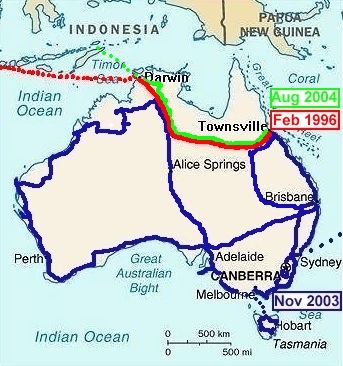 10-11/3/04 A short jaunt to Tumut where we are catching up
on necessary jobs. Catch up days are becoming more frequent. The lap top
allows easier web page updates, photo manipulation, much of which used to
be done between trips. The digital camera produces instant and many more
photos, all needing sorting, saving and backing up, only a few of which can
enter the web page. The older motorcycle, like us, requires more TLC (tender
loving care), days off.
10-11/3/04 A short jaunt to Tumut where we are catching up
on necessary jobs. Catch up days are becoming more frequent. The lap top
allows easier web page updates, photo manipulation, much of which used to
be done between trips. The digital camera produces instant and many more
photos, all needing sorting, saving and backing up, only a few of which can
enter the web page. The older motorcycle, like us, requires more TLC (tender
loving care), days off.
12/3/04 Cootamundra this year is holding the Great Race.
Traditionally its been Harley-Davidsons matched against Indians but with the
two bikes now drawn even at 5 all from the last 10 years of events the organizers
decided to call it a day. This year pegging North against South, that is
NSW and further north against Victoria and the southern states. All the motorcycles
must be pre swing arm, earlier than mid 50's built. 40 Harleys and 40 Indians
compete, 200 km's. More than half had already travelled from Sydney and Melbourne,
400-600 km just to get here. Their owners either old enthusiasts or young
enough to still kick start a motorcycle. We arrived early, watching the bikes
slowly roll into town. An impromptu party at the pub in the evening
had everyone meeting.
13/3/04 The main street was closed, except to motorcycles,
the bikes lined up on display, then let start at 1 minute intervals. The route
only given out five minutes before departure. Back country roads with an
observation sheet to complete. Points deducted for arriving too early or
late at checkpoints.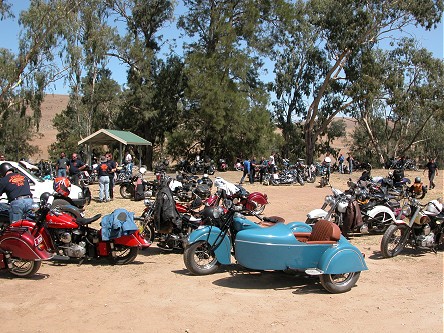 We watched the departure and shortcut across to the lunch stop watching arriving
bikes then back to town for the finish. An evening meal $80.00 (last minute
tickets for us $30.00) in the town's aeroplane hanger, aeroplane and all.
The locals put on a vaudeville show, black tie service and the presentations.
North won, by a small majority.
We watched the departure and shortcut across to the lunch stop watching arriving
bikes then back to town for the finish. An evening meal $80.00 (last minute
tickets for us $30.00) in the town's aeroplane hanger, aeroplane and all.
The locals put on a vaudeville show, black tie service and the presentations.
North won, by a small majority.
14/3/04 The Around Australia Anniversary Ride, by Graham
Felton and John Sinclair, a re-enactment of the 1929 event, is on it's promotional
lead up and heading for Geelong. They were at the Great Race yesterday and
we are travelling with them to the Ulysses meeting. On a 1940 H-D, similar
age to those in the race it has recently been rebuilt, again, suffering overheating
on another trip. We headed out with them to Echuca to the Murray River, 440
km, slow travelling, not arriving till 7 pm after many petrol stops for the
old bike, but without incident.
15/3/04 The threesome, the old 1940 H-D, the backup vehicle
with trailer carrying the wooden box sidecar and our motorcycle covered the
270 km to Geelong by early afternoon. Expecting 5500 participants, of which
4000 are to camp, the organizers had limited spaces to bikes, tents and trailers,
no 4 wheeled vehicles allowed on site. We were probably the smallest rig
for a couple, most with enormous tents and all the trimmings covering the
5x5 metre sites.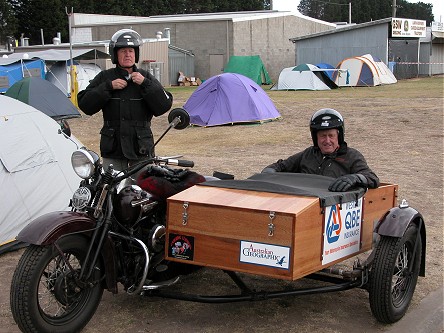
16/3/04 With our campsites in a prominent location Graham
and John set up their promotional display and with our sticker covered
motorcycle we attracted a steady flow of visitors. Mobile showers and toilets,
whole trucks specially fitted out, dotted the grounds. A post office to collect
equipment not carried, posted ahead, open on site, also available to post
gear home after the rally. Food vendors, Lions Club, Rotary and the Country
Women's Association feeding the masses. We settled in and our motorcycle
generated discussions of either awe or condemnation depending on the onlookers
brand preference and ability or willingness or time to take in the concept
of world travel, bearing in mind the age and staid mindset of the group.
(50+ to be a full member of Ulysses).
17/3/04 Baby boomers with disposable incomes they have
attracted all the major manufacturers to provide demonstration rides, almost
any motorcycle of any brand, about 150 to choose from. Camping trailers, dual
and single wheeled, a popular display, about one third of campers here already
towing trailers. A couple of pubs kept the people lively but to bed early
for the long week.
18/3/04 Four rides of the area had been organized, in all
directions, usually all day. We chose a quiet day, fixing the alarm, strengthening
the top box and posing for photos with the motorcycle for the Heavy-Duty
magazine photographer. The entertainment highlight, a "red faces" competition
where un- or semi-talented people often embarrass themselves as they perform
their party trick of acting in front of a large crowd to be applauded or
booed off stage. Always popular if only for the embarrassment factor. The
evening ended with a much more professional band.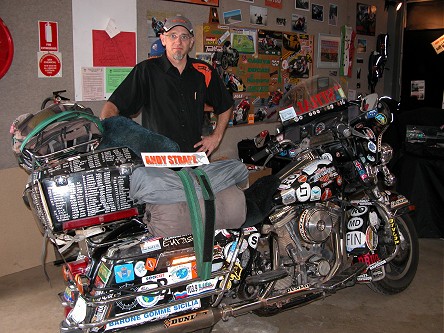
19/3/04 Andy of "Andy Strapz", often called Jock, agreed
to promote his product by giving us a couple of straps and making up some
bags to replace worn ones we carry our camping equipment in. We will collect
them in Perth in a few weeks time. The main promotional event of the week,
Honda giving away a Goldwing motorcycle. No ticket to purchase, just be there
at the draw after dinner. Needless to say we didn't win. 4500 people were
fed an evening meal in an enormous steel and vinyl marquis, dance floor and
band area.
20/3/04 This group of people seem not to mind lining up.
A long line to enter the marquis last night and bikes leaving early this morning
to be at the head of the parade of bikes. Phil (an ex overland African truck
driver) and us, not used to lining up, arrived right as the first bikes were
leaving in the parade and simply meshed in at the front of the crowd. The
city of Geelong had welcomed the Ulysses club and on their waterfront Yamaha
gave away a $20,000 gift voucher for any combination of their products, again
only rally registration required to participate. Heavy Duty magazine have
employed a journalist to write a series of three articles on our trip and
our first interview with Joy was this afternoon. Same marquis for dinner,
same number of people to feed, and an Aprilia/Moto Guzzi trip to Italy first
prize just for being there.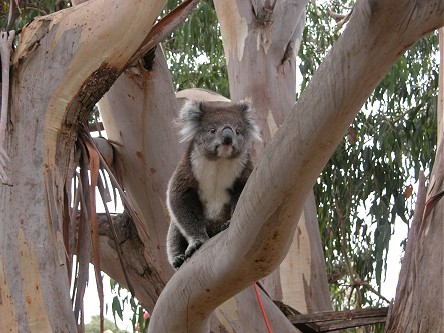
21/3/04 Packed up started early, the post office line long
for those sending gear home. The church service and last formalities missed
by most, leaving early to get home today, Sunday. Last goodbye's to the re-enactment
ride crowd and a couple of friends from Sydney and we headed down the Great
Ocean Road. A stretch that hugs the southern coastline, crowded with motorcycles
on any Sunday, worse today with rally departees. A few tourists had stopped
to watch four koalas sleeping in trees roadside and by evening we had spotted
a further nine, one even walked past our caravan accommodation, resting on
the concrete before ambling up a nearby tree. Otway National Park, protected
from dogs and cats, has many koalas, the tree often stripped of leaves before
they move on to greener trees.
22/3/04 West then inland, more spectacular coastal formations,
enormous arches and island pinnacles. This area is also known as the shipwreck
coast. Vessels sailing from England, after three months away from land, arrived
at the Australian coast. Often arriving in fog it was too late to see the
sheer wall of cliffs. Few survived due to the rough seas. Inland the Grampians
National Park, a mountain range rises abruptly from the surrounding flatlands.
Full of wildlife our campground covered in kangaroos grazing in late evening.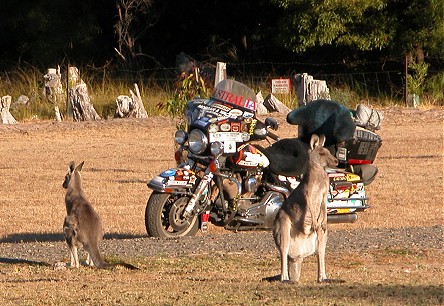
24/3/04 The Brambuk Aboriginal Centre, built in the shape
of a cockatoo, displays a film on Aboriginal culture and beliefs. The creation
theory not that dissimilar to that of western religions. A superior man (their
god) created the world and animals. Stories of how special land features,
like the Grampians mountains, were formed are part of folk lore with superhuman
animals changing the landscape. Other, "man spirits," have brought the rules
that their societies follow. The "religion" is really just an explanation
within the level of understanding of a peoples, for things that they can't
otherwise understand. The rules just a means of governing and organizing
the society. We walked to venus baths, a rock pool, now almost dry as little
rain has fallen.
25/3/04 Short ride and walk to lookouts over the valley
and town of Hall's Gap, another night in the Grampians. I recently turned
51 and am heading for that sway zone between not wanting more years and telling
people proudly how old I have managed to get. While we are looking forward
we want our age to look back but when we reach a reflective past our age
becomes exaggerated forward. Keep an active present and always be younger
than we really are.
26/3/04 Kangaroos are grazing grasslands all around the
park. We saw perhaps 500 eastern greys, along the road, thousands more must
be where the road doesn't go, forced onto open grasslands by lack of feed.
A real concern on a motorcycle as they tend to like grazing the mown roadside
for the short green pick. Middle of the day generally safe but early morning
and late evening a definite hazard, night time travel really dangerous out
here. Our route via Horsham to Kingston on the coast passed through small
wool and wheat support towns. Towns where nothing is locked and oils are
selfhelp at the unattended petrol pumps. Where the locals talk to strangers
openly and the price of things is surprisingly cheap from shop owners more
interested in service than profits. Where time is endless and they marvel
at the hurried traffic through town. We changed the motorcycle's oils in
one such town, buying two oils and being given the third free from bulk storage
along with them happily disposing of the old oils. A walk along Kingston
pier in the evening from which people were catching their evening meal of
bream and trevally.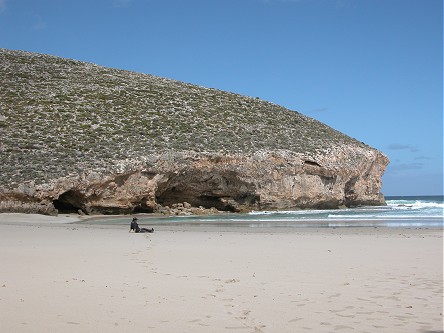
27/3/04 The Murray River flows into the enormous Lake Alexandrina
at it's mouth. The sand washed down forming the Coorong, a long sand dune
peninsula fronted by the ocean and backed by lakes, some dry leaving salt
pans and short salt tolerant vegetation, others are still lakes. Further
along we crossed the river by barge heading for Cape Jervis and a ferry to
Kangaroo Island. Australia's third largest island, 150 km x 50 km, it's isolation
keeping introduced species to a minimum and thus is favoured for wildlife.
Uninhabited when white man first arrived in Australia it also has some distinctly
unique variations of mainland animals. A quick introduction to the wildlife
when a pod of dolphins escorted the ferry, riding the bow wave for some minutes
before tiring. Fairy (little) penguins nest on the foreshores and on our
evening walk we saw dozens leaping out of the ocean to pair up with mates
guarding nests as this is the mating season. They can be seen standing under
street lights or waddling about town, their tell tale guano dolloped on the
pavement.
28/3/04 The sun rose over the water 180 degrees opposite
to where we had seen it set last night, however it soon disappeared and by
the time we were finishing a tour of the island's only eucalyptus oil farm
it was raining and looked set in for the rest of the day. We changed direction
and headed for a cabin in Kingscote rather than camping in the rain. Rained
all afternoon and showery overnight.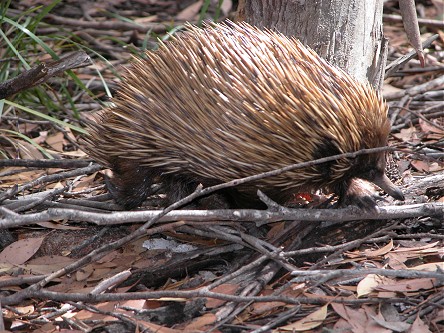 Eucalyptus oil was a large industry till the second world war on the island
but wool sheep were more profitable in the war years and the oil production
ceased. Revitalized recently at the hobby level and now growing to commercial
production, mechanization seems to be allowing for a competitive industry
again.
Eucalyptus oil was a large industry till the second world war on the island
but wool sheep were more profitable in the war years and the oil production
ceased. Revitalized recently at the hobby level and now growing to commercial
production, mechanization seems to be allowing for a competitive industry
again.
29/3/04 Skies grey but dry we headed to Cape Borda and
the Ravine Hike, 8 km to a secluded bay, flanked by limestone cliffs and wave
worn caves, the surf pounding in and windblown sand eddying up the ravine.
A long walk, worth the effort but without any wildlife spotted. To the south
and Rocky River campground, tame Kangaroo Island kangaroos, used to receiving
handouts grazed between sites. An evening stroll to the platypus water holes
to sight one scratching himself at the surface before diving leaving a trail
of bubbles, not to reappear.
30/3/04 Noisy Cape Barren geese flying past, a couple of
kangaroos bounding through our camp and other bush bird noises awoke us early.
The thick short trees shrinking to coastal heath in the saltier, windier
coastline where New Zealand fur seals were dotted around sunbaking on rocks
and playing in the calmer, warmer pools.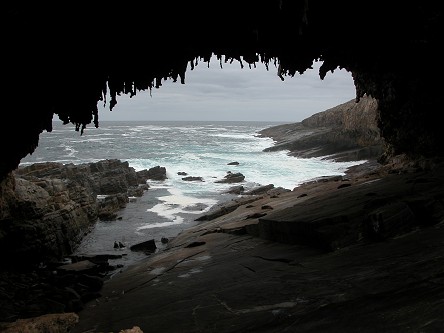 We visited some of the headlands around the lighthouse, watched the seals
for ages and returning for lunch to the camp watched a friendly echidna rummaging
through the bush looking for grubs and insects. An evening walk from the
camp revealed many koala, waking up to feed in the tree tops, more echidna
and Tammar wallabies emerging from the scrub to graze on open grasslands.
We visited some of the headlands around the lighthouse, watched the seals
for ages and returning for lunch to the camp watched a friendly echidna rummaging
through the bush looking for grubs and insects. An evening walk from the
camp revealed many koala, waking up to feed in the tree tops, more echidna
and Tammar wallabies emerging from the scrub to graze on open grasslands.
31/3/04 Up before 6am, walking the 4.5 km loop track, hoping
to get another sighting of platypus feeding in the ponds. Smarter than us
they were probably tucked up in warm burrows as we didn't see any on this
cold morning. The island has many attractions we chose not to visit mainly
due to cost or having seen similar sites before. A limestone cave, two lighthouse
tours, seal colony tour, all of which are visited by the tour group buses,
pushing prices higher and our enjoyment lower if caught up with a tour group.
Back to Penneshaw for the night.
1/4/04 Caught the ferry back to the mainland and headed
for Adelaide. We had lived here for three months, in our late teens, together
but at separate abodes. The place has grown beyond recognition, the satellite
suburbs now part of the city sprawl and the traffic annoying after an island
almost to ourselves. We reassessed our desire to stay, illegally parked the
motorcycle on the footpath, sitting on a city bench, snacking, suits hurrying
past, buses drowning out our conversation. The need to see another museum
or lovely stone building not as great as the desire to be on the road. Clare
for the night, 123 km north, rolling hills of grape vines and old wineries
in small towns.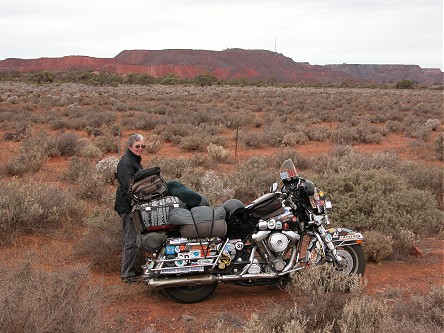
2/4/04 It's an interesting situation I have observed that
many of the travellers we meet act and profess to be less financially fluid
than they actually are. Only recently did I realize that appearing less wealthy
divides the best and worst people you meet. It brings out the best in the
best people and the worst in the worst people. An opportunity for the reason
to feel good helping someone less fortunate as opposed to a superior attitude
of being better than someone else. The traveller also takes on the humbling
position of allowing themselves to be helped rather than the arrogance of
their independent mode of life. Dressed as we are, in worn no brand clothes,
a little dishevelled, riding a used looking motorcycle, needing an engine
mount bolt, one of those best of people spent time measuring, finding and
cutting a bolt to fit, allowing us the independence of experience to install
it, charging a nominal, face saving price for the item and a wave of the
hand for his assistance. Stopped in Port Augusta to stock up on food for
the Nullarbor, crossing to Western Australia.
3/4/04 Pt Kenny to Ceduna, 200 km, deciding to catch up
on chores. Three one nighters and prospects of another couple across the Nullarbor
made the decision. Ceduna, population 3200, really just a staging post, the
locals either working in fishing or tourism support, the town is hotels and
caravan parks, however everything still closes lunchtime Saturday to Monday
morning.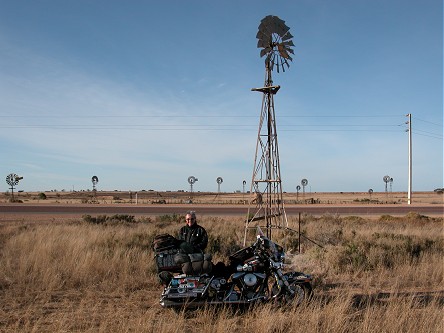 The big Saturday night event this week is dirt track racing, obviously extremely
popular, fielding 30 cars from this small population. Novice cars through
to super modifieds thumped the track, collisions and losses on corners. The
only bright light in a quiet town.
The big Saturday night event this week is dirt track racing, obviously extremely
popular, fielding 30 cars from this small population. Novice cars through
to super modifieds thumped the track, collisions and losses on corners. The
only bright light in a quiet town.
4/4/04 Nothing happens here on Sundays. Lacking from our
web site have been captions on all the photos. A mammoth task, chipped away
at in our spare time, completed today.
5/4/04 The world's largest lump of limestone, 250,000 sq/km,
is the Nullarbor, flat and generally without trees. The road along the coast
touches only the southern most tip and parallels the sheer 90 metre high
cliffs for 200 km's. There are no towns or villages for 1200 km from Ceduna
to Norseman, just roadhouses, there only for the passing motorist, fuel,
food and various accommodation, all outrageously overpriced, fuel 50% dearer
than nearest cities. But the average tourist will need at least one petrol
or overnight stop so prices can remain high. In the dream to travel around
Australia everyone must pass here.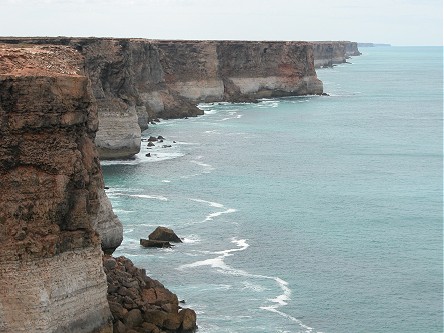 4x4's towing caravans the preferred rig, some heading east but at this time
of year the majority westbound, retirees, poor to wealthy, three months to
the rest of their lives, some happy some wishing they were home. Others on
motorcycles, with or without trailers, pass us, even a gypsy wagon, horse
drawn with dog, all intermingled with the road trains, semi trailers with
an extra trailer. The traffic not busy, just dotted every km or so, even
the roadhouses quiet, with long range fuel tanks and camping wild people
avoiding the high prices where possible. It's never glassed out here, the
wind always blows from one direction or another, we had a hot tail wind,
then a cross wind increasing before a front line of cloud dropped temperatures
12 degrees and a headwind. We camped out, off the road, an old gravel dump
behind a mound of dirt out of the wind, 830 km, away from the roadhouses,
the caravans in rest areas, the sunset and stars to ourselves, just off Australia's
longest straight road, 150 km unbending.
4x4's towing caravans the preferred rig, some heading east but at this time
of year the majority westbound, retirees, poor to wealthy, three months to
the rest of their lives, some happy some wishing they were home. Others on
motorcycles, with or without trailers, pass us, even a gypsy wagon, horse
drawn with dog, all intermingled with the road trains, semi trailers with
an extra trailer. The traffic not busy, just dotted every km or so, even
the roadhouses quiet, with long range fuel tanks and camping wild people
avoiding the high prices where possible. It's never glassed out here, the
wind always blows from one direction or another, we had a hot tail wind,
then a cross wind increasing before a front line of cloud dropped temperatures
12 degrees and a headwind. We camped out, off the road, an old gravel dump
behind a mound of dirt out of the wind, 830 km, away from the roadhouses,
the caravans in rest areas, the sunset and stars to ourselves, just off Australia's
longest straight road, 150 km unbending.
6/4/04 We were underway half an hour after sunrise, the
air crisp, the wildlife still active, kangaroos and emus crossed the road
ahead of us a few times over the next hour, mostly at a distance, once close.
Eagles and crows attacked fresh kangaroo road kill and bustards flew to their
daytime roosts.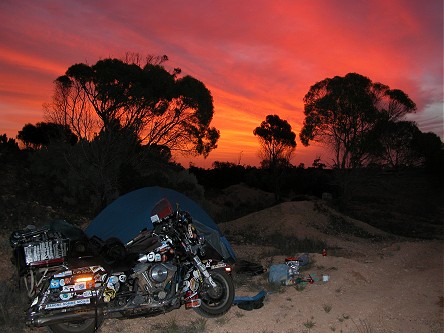 The vegetation grew to taller salmon gums, from short saltbush, their outer
bark recently dropped revealing silky salmon coloured trunks and shiny leaves.
One roadhouse for fuel, then Norseman for fresh bread lunch and Esperance
on the coast to rest. A real town, supporting the wheat industry, also catering
for the tourists. An evening walk along the beach but mainly resting, 1400
km in two days.
The vegetation grew to taller salmon gums, from short saltbush, their outer
bark recently dropped revealing silky salmon coloured trunks and shiny leaves.
One roadhouse for fuel, then Norseman for fresh bread lunch and Esperance
on the coast to rest. A real town, supporting the wheat industry, also catering
for the tourists. An evening walk along the beach but mainly resting, 1400
km in two days.
7/4/07 A 39 km loop road travels along the coast, islands
dotted offshore, and past the pink lake, really mauve, inland. Esperance's
other main interests are the local museum, main exhibit, bits of Skylab, the
first space station, landed near here in 1979, and the fish leather factory,
skins of fillets, made into buttons, pens, shoes etc, previously a waste
product.
8/4/04 Forecast of rain, which eventuated at 2 pm till
dark, and accommodation shortage nearing Easter kept us "at home" for another
day.
9/4/04 Further west, dodged or caught the edge of a couple
of thunderstorms, waiting out one at a petrol station coffee shop meeting
a Japanese lady riding a Suzuki 250 around Australia, 28,000 km so far, only
half way for her. A detour to the Stirling Ranges, Bluff Knoll lookout and
a walk through autumn wildflowers, Porongurup National Park and another walk
through the Karri forests, Easter busy campground nearby.
10/4/04 Looped out to Albany, shopping and a visit to the
Sandalwood factory. A free tour, captive audience to sell products derived
from sandalwood, mainly cosmetics but also used in alternative healing methods.
A native tree to Western Australia. Mt Barker and it's Banksia nursery, having
a complete collection of all 77 varieties, a uniquely Australian plant, with
unusual flowers.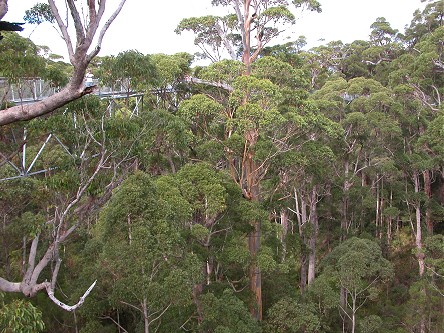 Most people however come to this region for the wineries, not as famous as
Margaret River, to the west, but the drier area produces rieslings and chardonnays,
as well as reds. We joined many Easter wine tasters, visited two wineries
and took a sample back for dinner, same campground.
Most people however come to this region for the wineries, not as famous as
Margaret River, to the west, but the drier area produces rieslings and chardonnays,
as well as reds. We joined many Easter wine tasters, visited two wineries
and took a sample back for dinner, same campground.
11/4/04 Red Tingle is a species of tree that only lives
in a 6000 hectare area in South West, Western Australia. Australia's biggest
tree at the base and third tallest. A 600 metre boardwalk into the tree's
canopy, 40 metres above the ground is an engineering feat. Not wanting to
disturb the trees yet allowing visitors, this open steel walkway is supported
on just seven poles, 100 metre spans, that rock and sway in the wind and
with tourists, making some a bit seasick and many a bit more nervous. Up
in the crowns of the trees looking down and up it's easier to appreciate their
60 metre height. Camped at Shannon, an evening ranger video outlined the
advances this state has made against the fox and domestic cat, introduced
species, decimating small mammals which previously had no predators. The poison
1080, derived from local pea bushes, (now synthetically made), is dropped
from aircraft over the entire state, four times a year. The local animals
having evolved with the bush are immune, introduced species are killed. The
program is having enormous success with all populations of small mammals
increasing, some were previously very endangered with extinction.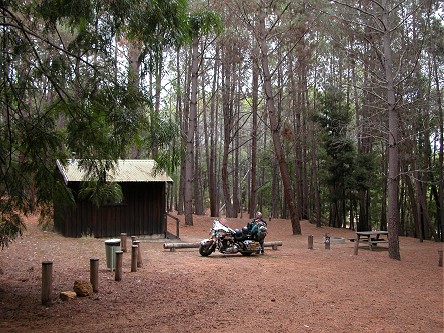
12/4/04 Easter's over, everyone packed up leaving one cabin
empty. Sitting on the hill in a pine forest, slab walls and a pot belly stove,
four bunks but no mattresses and the same price as camping we took it and
stayed another night. A loop ride through Karri forests to the Dave Evans
Bicentennial Tree. This forest used to be logged and fire being a threat
to that resource the forestry department pegged trees and built watch towers
in their crowns to scan the hillsides for burgeoning fires. The Gloucester
Tree was pegged in the 1930's, wooden pegs driven into the tree spiralling
but climbing steeply to its 60 metre height. We climbed this tree 17 years
ago with our children after the forestry had moved to using spotter aeroplanes
for fires and turned this tree over to tourism. With increasing tourism demand
the Dave Evans tree was pegged, using metal spikes, it rises 65 metres to
the top tower, so today we climbed to it's top with magnificent views over
the lesser trees in the forest. Back to our cabin to listen to rain on the
tin roof warmed by the pot belly stove.
13/4/04 Into Perth but still not ready for a city,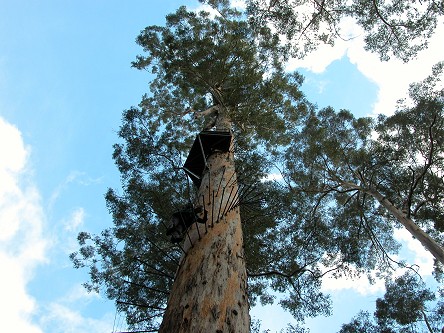 just to pick up a couple of replacement bags made especially for us by Andy
Strapz. Two bags for our mattresses and two bags for the sleeping gear (bag,
sheet and pillow) which sits in the sun on the outside of the bike. Headed
a further 100 km north, 500 km total including an oil change.
just to pick up a couple of replacement bags made especially for us by Andy
Strapz. Two bags for our mattresses and two bags for the sleeping gear (bag,
sheet and pillow) which sits in the sun on the outside of the bike. Headed
a further 100 km north, 500 km total including an oil change.
14/4/04 250 km north of Perth, along the coast, is an unusual
formation of rock and sand called The Pinnacles. Old sand dunes, converted
to limestone rock, weathered, recovered in sand and uncovered again formed
these 2-4 metre high pinnacles surrounded by yellow sand. A 3.5 km track
winds through them giving ample photo opportunities. The coast road north
visits small lobster villages and isolated fishing huts before the more major
town of Geraldton.
15/4/04 This area of coast is famous for it's lobster fishing.
We visited a co-operative of 159 boats, designed to help market live shipments.
The Japanese, Chinese and American markets all require different sizes and
colour for their customers. Sorted and graded the lobster are kept fresh
in holding tanks awaiting a market order and can be flown anywhere in the
world to arrive live within 36 hours.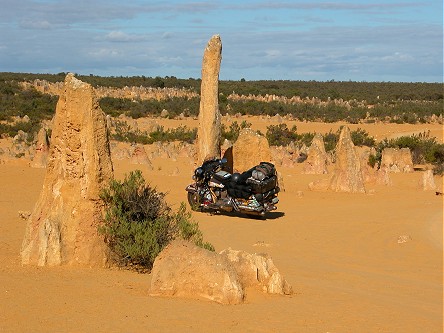 We bought a non-export quality (more than one leg missing) half kilogram
lobster, $12 Aust, just for a taste. This area of coastline is also famous
for shipwrecks. The Dutch trying to reach Indonesia (the spice islands) in
the 1600's occasionally ploughed into Australian islands before they could
head north. The first known white people to come ashore to Australia to live
were from the wreck the Batavia in 1629. Originally stranded on offshore
islands where they mutinied and murdered each other, two were put ashore
on the mainland and left. Blood samples of local aborigines indicate a Dutch
disease, prevalent in Holland at the time, also carried in the indigenous
blood, indicating co-habitation with the natives.
We bought a non-export quality (more than one leg missing) half kilogram
lobster, $12 Aust, just for a taste. This area of coastline is also famous
for shipwrecks. The Dutch trying to reach Indonesia (the spice islands) in
the 1600's occasionally ploughed into Australian islands before they could
head north. The first known white people to come ashore to Australia to live
were from the wreck the Batavia in 1629. Originally stranded on offshore
islands where they mutinied and murdered each other, two were put ashore
on the mainland and left. Blood samples of local aborigines indicate a Dutch
disease, prevalent in Holland at the time, also carried in the indigenous
blood, indicating co-habitation with the natives.
16/4/04 The shipwreck museum we visited yesterday required
another hour this morning along with grocery shopping as this is the last
major centre for a week. Headed north late, just 150 km to Kalbarri, about
the furthest north school holiday makers get, a sandy river mouth, rocky headlands
and plenty of fishing. That great sport (not appreciated by me) that involves
the whole family, eats up more money than any other sport and gives little
if no reward for effort, but allows the participants to relax and enjoy a
cold beer whilst actively participating. We strolled the beachfront weaving
between rod and casting lines. 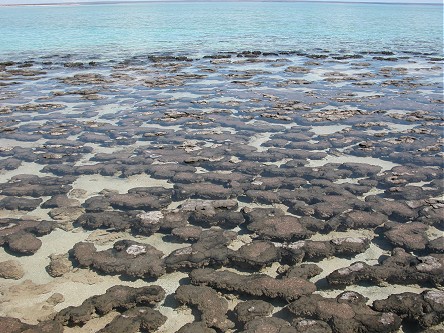
17/4/04 Further up the Murchison River, red gorges with
permanent water attract tourists. Walks to "natures window", "the loop" and
"Z bend" have the more energetic canoeing or swimming or abseiling. We arrived
early trying to avoid the heat, still 35 degrees today, paddled our feet
in the Z bend and were inundated by flies trying to drink our salty perspiration.
Apparently an early storm hatched the black things early this year.
18/4/04 Shark Bay, another World Heritage listed area,
the world's oldest living organisms, stromatolites believed to have evolved
3.5 billion years ago and responsible for creating the oxygen necessary for
other life forms. Just blobs in the salty waters here and in the Bahamas,
the only places they now survive. Further up the peninsula is shell beach,
small bivalves discarded shells, make up 100 km of beachfront, here for thousands
of years some have cemented together and are cut and used for building blocks,
others are mined for their limestone, cement lime, fed to chickens for egg
shell or used as road stabilization. Shark Bay peninsula is just over 3 km's
wide at one point and expanding into 1000 sq/km's the other side making it
perfect to fence off from non native predators. A 2.4 metre high electric
fence running out into the ocean either side prevents unwanted animals re-entering
the area cleared of over 32,000 feral sheep and goats and baited for cats
and foxes. The area is now being used to reintroduce endangered species from
captive breeding programs or taken from where stable populations exist. Camped
at Monkey Mia Resort.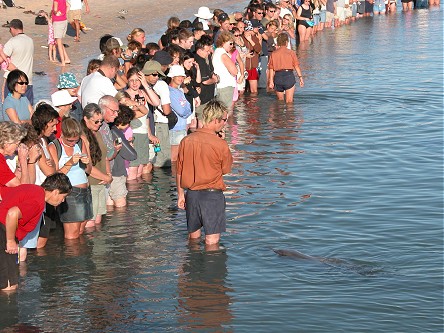
19/4/04 About 40 years ago a couple of dolphins started
following fishing boats in this area, receiving a few by-catch fish. When
we were here 17 years ago it had developed into tourists feeding about seven
dolphins under the supervision of National Parks, a couple of dozen people
a day and a small caravan park primarily for the fishermen. Today the tourists
number in their hundreds each day and the number of dolphins being fed had
also increased, however it was recently reduced to females (less aggression),
over 11 years old (already adapted to their own environment), and just 2
kg of food each (1/3 rd of their requirements to ensure they still hunt and
interact). Four females were fed today, their three calves watching on, six
males hanging close keeping their partners in range. A bit of a show, with
the dolphins being "walked" past the crowd for everyone to see. The public,
chosen randomly, are given small fish to hand feed a dolphin. It's about
as close as people are ever likely to get to dolphins living in the wild,
almost everyone within two metres, the dolphins sometimes brushing against
their legs. A range of informative talks and videos accompany the experience
interspersed during the day. Of course the small van park is now a resort,
but still remembers its roots. We camped there, using the resort's facilities.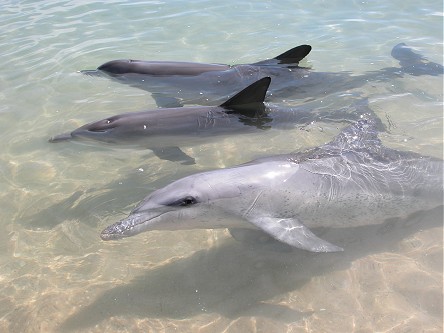
20/4/04 Travelling around Australia (or around "the block"
as some travellers call it) is said to be easier going clockwise, the wind
is at your back, most of the time. It certainly has been for us. Today a
strong southerly moving us along to the north, Carnarvon, an agricultural
town, drawing water from underground aquifers in this desert environment.
A short stop to restock food and fuel, 70 km further north to the coast and
Quobba Point blowhole. A small temporary fishing village of caravans and
shacks has grown up here over years. A rugged existence with no water, no
trees and windswept land and big waves offshore. We camped with fine sand
entering the tent in an unpleasant wind.
21/4/04 With good roads and people travelling further the
school holidays crowd has packed out Coral Bay, not a tent site to be found.
With the reef coming right into the bay, still warm, when down south is entering
winter, it's the perfect family holiday destination. Unfortunately with nowhere
to stay we looked around for an hour then moved on to Exmouth.
22/4/04 Hot and tired, an air-conditioned room for two
nights, relaxed doing catch up jobs.
23/4/04 Ningaloo is the Great Barrier Reef's cousin, situated
on the opposite, western, side of Australia, 250 km long, the reef fringing
the shore. Exmouth is a real town, built originally to support the nearby
naval base, some fishing and now tourism. Just 2500 locals and a lot more
tourists. It's season spread out by whales, turtles and whale sharks visiting
at different times of the year. Now it's whale sharks, seven boat operators
with up to 20 passengers each, guided by spotter planes, dump snorkellers
mid ocean, ten at a time, near the front of these gentle giants. Unable to
keep pace with the shark, the next batch of snorkellers are dumped and the
first retrieved. This process goes on till either the whale shark dives too
deep or the snorkellers get too tired or bored having had full value of their
$A320.00 cost. We chose to dive and snorkel the Muiron Islands, just offshore.
Exmouth Dive Centre, professionally run, pleasant if nothing exceptional
at the dive locations, limited visibility after rough seas and plankton.
The reef here not as spectacular as where we used to dive on the Barrier
Reef.
24/4/04 Grabbed some snorkel gear and headed into Cape
Range National Park, along the west coast, and as far west as we can ride
in Australia. There are beach entry points along the 70 km of road, some offer
boat launching, others camping or snorkelling. We set up camp, a sand dune
back from the beach, 50 metres from anyone else at Ned's Camp. The ranger
interpretive centre showed a video, more information on whale sharks and
we snorkelled at Lakeside. Small patches of lagoon reef, tucked in behind
the main wave breaking outer reef, exist one to two hundred metres offshore.
Here, snorkelling in 3-4 metres of water, we spotted a few turtles, two white
tip reef sharks, anemone and their fish, an octopus, scorpion fish plus many
other corals and edible fish. A truly amazing array of marine life all in
the one small area.
25/4/04 Water being our limiting factor in camping here,
overcome by drinking boiled bore water from an underground, capped source,
allowed us an extra day to look around the park and coast.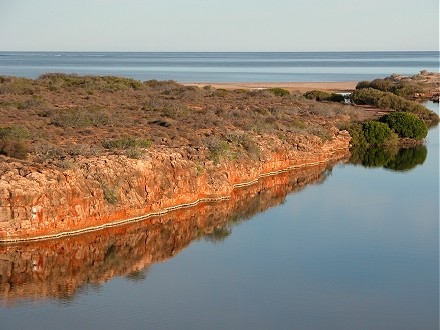 Yardie Creek Gorge at 6.30 am, brilliant colours, mirrored in the clear waters.
More snorkelling, three more locations, plate corals, staghorn, blue lagoon
coloured water, warm in and hot out of the water. Watched another sunset,
moon rise and bright stars.
Yardie Creek Gorge at 6.30 am, brilliant colours, mirrored in the clear waters.
More snorkelling, three more locations, plate corals, staghorn, blue lagoon
coloured water, warm in and hot out of the water. Watched another sunset,
moon rise and bright stars.
26/4/04 Back to town, totally exhausted by sun and water,
spent the day washing, internet and relaxing. Also the exhaust pipe had again
started leaking behind the rear cylinder at the join. More putty and this
time an extra hose clamp hopefully will hold it together better on the corrugated
dirt roads.
27/4/04 Left at 6.30, the kangaroos still about but the
temperature cool and expecting an easterly later in the day, as many k's covered
before it becomes a strong headwind. 640 km's to Tom Price, a mining and
mine support town of 3000 people, purpose built by the mining company. It's
the end of a good wet season with grass as tall and green as it gets out
here, contrasted against the red rock and sand. Floods have been through the
creeks, water in the billabongs, some sections of road damaged by the last
rain depression the result of a coastal cyclone six weeks earlier.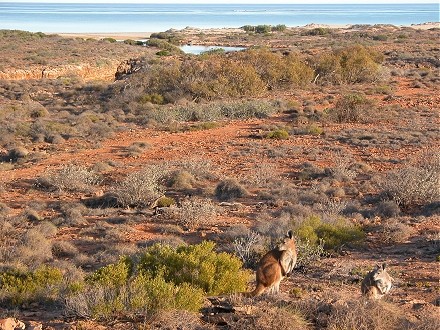 Ore trains shunt through town regularly, iron ore to the coast 300 km away.
We cooked another gel battery 50 km out of town, just two months old, not
sure now if it's the bike's electrics or the batteries that are the problem.
Bought a small quad bike battery and mounted it on the rear footboard, leads
extended, obviously no H-D batteries available around here. The failure also
seems to have blown something in the alarm system, it re-arming itself every
30 seconds even when we are riding, so we arrived in town well noticed, Kay
holding the remote disarmed it each time it re-armed, siren blaring. Exhausted,
just before dark, we could relax after setting up camp.
Ore trains shunt through town regularly, iron ore to the coast 300 km away.
We cooked another gel battery 50 km out of town, just two months old, not
sure now if it's the bike's electrics or the batteries that are the problem.
Bought a small quad bike battery and mounted it on the rear footboard, leads
extended, obviously no H-D batteries available around here. The failure also
seems to have blown something in the alarm system, it re-arming itself every
30 seconds even when we are riding, so we arrived in town well noticed, Kay
holding the remote disarmed it each time it re-armed, siren blaring. Exhausted,
just before dark, we could relax after setting up camp.
28/4/04 The headlight bulb had blown two days earlier so
this morning we swapped it with the spare, totally disconnected the bike's
alarm and departed for Karijini National Park. Karijini is a place of gorges,
iron ore rust red, deep and narrow. The surrounding plateau, scrubby bush,
drought gums and spinifex grasses. All it's interconnecting roads are dirt,
chopped up or washed out by recent rains. We reduced tyre pressures and set
up camp at Savannah camp, a new campground, run jointly by the indigenous
people and national parks service. A walk down into Joffre Gorge, a waterfall
to pools, cool in the afternoon heat.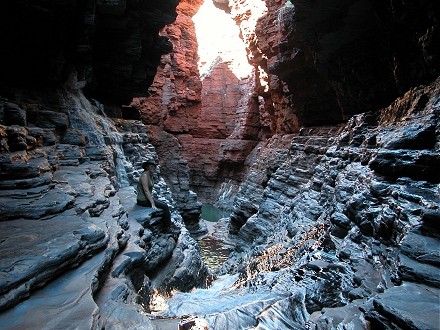
29/4/04 The new showers are an adaptation of old ways and
new technology. Solar heating and plastic header tank allows hot and cold
water to a canvas bucket with shower nozzle, to be filled and raised on pulleys,
the old bush shower way. Two gorges, Hancock first after visiting the confluence
of four impressive gorges. A walk to the bottom, rock hopping, scrambling
to sit in solitude. The sheer cliffs often only 2 metres apart rising 100
metres high. Next Weano Gorge, similar red hues, steep sides but it's necessary
for us to swim through cold waterholes to progress to where it joins Hancock
Gorge. Again narrow sections opening out to large pools. A strenuous but
relaxing day, reading books in the cool gorges away from the flies, just
spending time.
30/4/04 A four metre Pilbara Olive Rock Python had been
sighted near the bottom of Joffre Gorge yesterday and the ranger escorted
us to it's location this morning. Curled up under a rock ledge it waited,
like us, for the sun to rise, not till 9.30, deep in the gorge. They feed
on birds drinking or passing rock wallaby joeys. Dales Gorge, at the other
end of the park, actually two gorges merging. Circular Pool, at the base of
a cliff, fed by crystal clear seepage, then a walk along a more open gorge
with paperbarks and milky pools before also ending in a waterfall pool.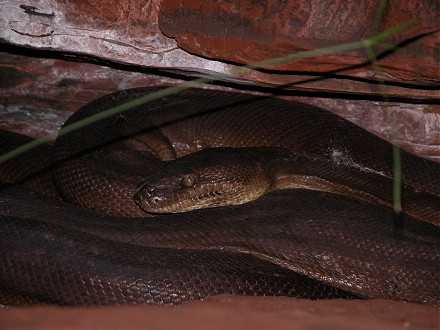 This area used to be sacred to the aborigines, a special place. It is also
now a place where quiet enjoyment is better appreciated.
This area used to be sacred to the aborigines, a special place. It is also
now a place where quiet enjoyment is better appreciated.
1/5/04 360 km to Port Hedland, the mining supply town,
red with iron ore dust staining buildings, blown in from the enormous ship
loading facility. Still growing in it's throughput the single train track
to Hamersley mine to be upgraded to double track allowing greater tonnage
to be exported. We bumped into a couple of friends from Townsville, now working
over here. Ones we haven't seen for five years, stayed at Lucy and Graham's
house catching up. It's a place to come and work for good money but few would
call it home.
2/5/04 630 km to Broome. The winds along this coast are
strong in the morning but easing in the afternoons. Straight into a headwind,
along a generally uninteresting stretch of flat road. The wind knocking us
and the fuel consumption about.
3/5/05 Different cultures have different requirements and
with many different nationality groups in Australia, including the indigenous
Aborigines, and with equal rights, some specific rules encompassing the whole
of society must be made to control certain habits of one group. Alcohol consumption
by Aborigines is a problem in this region and along with Australia's social
welfare system, where unemployment benefits are paid by the government and
for an entire lifetime if no work is found, we now have four generations
of people who have never worked, getting paid what is locally known as "sit
down money". This system commenced in the 1960's with equal rights but didn't
allow for different cultural effects. Alcohol sale laws in this region have
taken on interesting regulations. Like, no alcohol to be sold before 6 pm
on Thursday's and Fridays, the day the government pays its social welfare.
No 4 litre wine casks to be sold in some areas, a preferred, easy to get
drunk, cheap drink.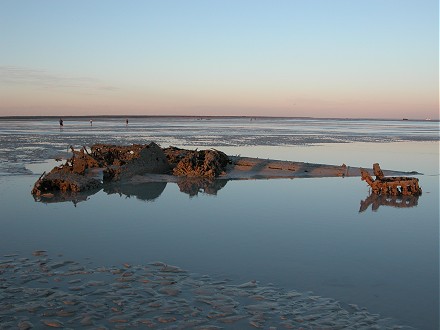 After 5 pm only 1/2 cartons and small bottles of spirits to be sold. As we
cannot discriminate in this country on race or creed everyone in the region
must abide by the same rules. Broome is famous for its pearls, having the
largest pearl oyster, it used to produce 80% of the world's mother of pearl
shell for buttons. Long ago the industry died out replaced by plastics or
cultured pearls but its history still draws tourists to the area. The warm
climate and a large supply of pearl jewellery shops keeps them entertained.
We checked out a few shops, buying nothing, marvelling at the array of artwork,
and the price of this product of man and nature.
After 5 pm only 1/2 cartons and small bottles of spirits to be sold. As we
cannot discriminate in this country on race or creed everyone in the region
must abide by the same rules. Broome is famous for its pearls, having the
largest pearl oyster, it used to produce 80% of the world's mother of pearl
shell for buttons. Long ago the industry died out replaced by plastics or
cultured pearls but its history still draws tourists to the area. The warm
climate and a large supply of pearl jewellery shops keeps them entertained.
We checked out a few shops, buying nothing, marvelling at the array of artwork,
and the price of this product of man and nature.
4/5/04 A few motorcyclists are congregating in the area.
Three at our camp site and a couple of others about town. The Gibb River road
through the northern Kimberley's has been closed for the wet season, now
recently graded, people are gathering, however having been a wet, wet season,
there are two rivers, fast flowing up to 70 cm deep and up to 600 metres
wide. It might be a couple more weeks before motorcycles will be crossing.
Dunlop had arranged for us to collect a tyre here, which we did this morning
along with regreasing the swing arm bolt, known to have rusted tight previously,
but now on our regular maintenance program.
5/5/04 The large tides and extensive mud flats cause an
unusual sight when on a low tide, full moon night, the moon rising over the
horizon forms reflected lines across the mud flat ripples, like a staircase
to the moon. Two nights a month crowds gather on the beach to watch its appearance,
as we did tonight. Occurring just once a month, on a negative tide, two km's
across the mud flats, are the remains of 16 float planes, sunk here by the
Japanese during the second world war in 1942. The engines and any aluminium
structure, partially immersed in the mud, are visible and well preserved.
We oozed tidal mud through our toes, as fascinated by exposed marine life
as of that of the aeroplanes. Small nudibranch, octopus, tube worms, sea
stars, usually graceful underwater now fumbling in the muddy expanse.
6/5/04 The end of the blue ocean at Broome, replaced by
swirling muddy waters of Derby, wedged between a peninsula and the mainland
the 11 metre tides rush in and out twice daily across the mud flats. Derby,
a non-tourist town's claim to fame is an enormous Boab tree, (cousin of the
African Baobab) 14 metres circumference and believed to have been used as
an overnight prison, utilizing its hollowed out interior. Now considered an
Aboriginal sacred site, fenced off from intruders. Travelling with Peter,
another Australian, on his 5 month trip around Australia, a "personal time
trip" for him, away from his family. Riding a 650 Honda Transalp we headed
"off-road", along the Gibb River road for a while, then into Windjana Gorge.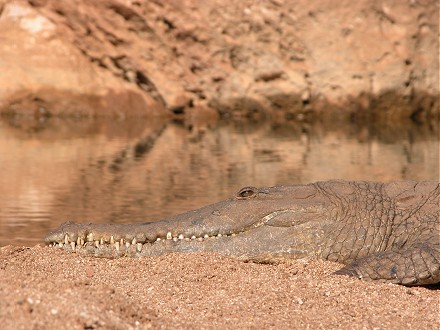
7/5/04 The gorge is one of the easiest places to see Australian
freshwater crocodiles. At 2 metres they are much smaller than the saltwater
crocodiles, eat fish and generally leave humans alone to utilize the same
area and even swim with them safely. Tolerating each other, close photography
is possible as they sun themselves, digesting their dinner on the sand bank
early mornings. We walked through the 90 m high gorge, limestone, part of
an old sea bed, goanna, corellas and even a snake crossed our early morning
walk. Just 40 km's away a different creek has cut a 750 m tunnel through
the limestone reef. Walking thigh deep in water, halfway, the collapsed ceiling
allows light, but elsewhere a torch is necessary to find the sandy, rocky,
wet path to the swimming pool where the creek emerges. A cool place on a
hot humid day after last night's thunderstorms. The dirt road to Fitzroy Crossing
still muddy with water in some crossings.
8/5/04 Geike Gorge, a different tourist spot, boats ferry
caravan or fly in travellers up the Fitzroy River with interpretative commentary.
We chose to walk its banks, more freshwater crocodiles. Later in the day travelling
300 km to Halls Creek. A predominantly aboriginal community of just over
1000 people plus a support town for tourists.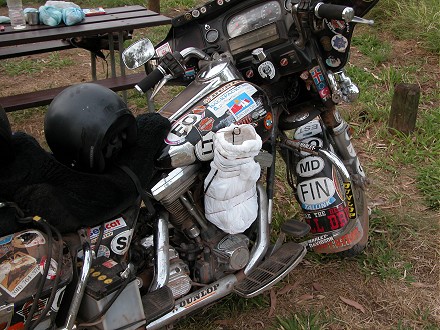 I walked to its more dark end in the evening where, as happens every night,
a couple of hundred aborigines gather inside or outside the local hotel to
drink. An old man was sitting in the gutter singing, playing his guitar, three
or four women singing along melodiously. Small groups of half a dozen were
sitting on the road, at its edge or in the long grass, with their mates,
ones who had the money or alcohol. There were no other white people there
other than security who politely vetted who was or was not allowed entry
to the pub. Dress and alcoholic state the main criteria but previous disturbance
offenders also banned. It was described as a quiet evening, everyone happy,
friendly, shaking my hand or telling me stories of themselves. All ages from
18 to death, their children fending for themselves to follow their parents
when they reach drinking age. Most live in the long grass, emerging on their
government hand out day to collect from the bank and return it through the
bar.
I walked to its more dark end in the evening where, as happens every night,
a couple of hundred aborigines gather inside or outside the local hotel to
drink. An old man was sitting in the gutter singing, playing his guitar, three
or four women singing along melodiously. Small groups of half a dozen were
sitting on the road, at its edge or in the long grass, with their mates,
ones who had the money or alcohol. There were no other white people there
other than security who politely vetted who was or was not allowed entry
to the pub. Dress and alcoholic state the main criteria but previous disturbance
offenders also banned. It was described as a quiet evening, everyone happy,
friendly, shaking my hand or telling me stories of themselves. All ages from
18 to death, their children fending for themselves to follow their parents
when they reach drinking age. Most live in the long grass, emerging on their
government hand out day to collect from the bank and return it through the
bar.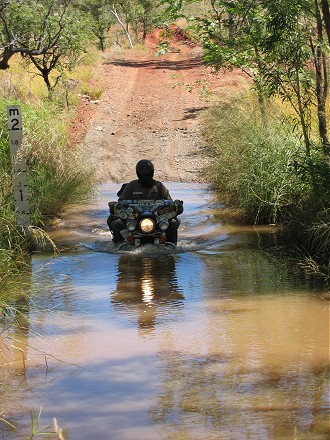
9/5/04 We were now three motorcycles. Lincoln, riding a
KTM 640, Motard, joined us for the attempt to get into the Bungle Bungles.
A four wheel drive access only road. Reports of 40+ cm deep water crossings
had prepared us to make a snorkel for the air intake. By removing the air
filter and attaching another gasket to a doubled up plastic bag and placing
it between the carburettor and the air filter, then placing the filter inside
the plastic bag. An old plastic drink container inside the bag extended the
intake higher. The 53 km's of dirt was generally good, twisty, hard packed,
with some rocky ridges. There were many shallow creek crossings but three
were at 45 cm's and one at 55 cm's. With the snorkel the three shallower
ones were negotiated, the pipes spluttering underwater and a few coughs from
the motor. The deeper crossing had the bike stall mid water. The oil dipstick
popped out and water filled the sump. Pushed to the bank, the water was drained
from the bottom of the sump and the oil topped up. Lincoln and Peter had
an easier time, their motorcycles designed for deeper water, however they
unloaded and reloaded them, carrying gear across some crossings just in case
a bike was dropped. Set up at our camp we spent the afternoon in Echidna
Chasm. A gorge of conglomerate sides, 100 metres high, narrowing to one metre
wide, ending abruptly in a vertical wall. A great place to rest in the cool
after a tiring, physically and mentally, ride.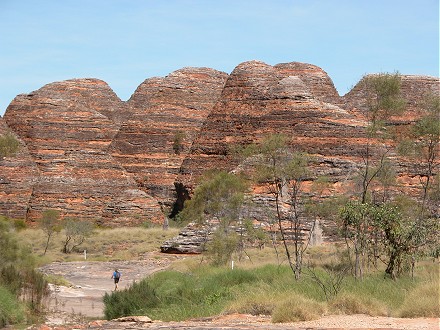
10/5/04 A relaxed start, planning to spend most of the
day in the southern section, a 24 km ride, mostly good dirt. A large frilly
necked lizard crossed our path and waited long enough for us to take his photo.
This area of the park are the real Bungle Bungles, sandstone domes of orange
and black stripes, the colour from different layers of clay, giving different
porosity and allowing the black algae to either grow or not grow. Erosion
making the beehive effect. Cathedral Gorge is in the middle of thousands
of these domes, a chasm, water plunging in flood times to a deep pool. We
also walked along Piccaninny Creek, swimming in one of the fast drying waterholes,
nibbled by the small hungry fish, cleaning off our dead skin.
11/5/04 The deep water snorkel was slightly modified for
the outward journey, plastic water bottles cut to allow better airflow to
stop the plastic bags being sucked onto the filter and the carburettor bowl
overflow hose lifted above expected water level. The creek crossing had receded
slightly, the motorcycle handling each one this time without coughing or
problems,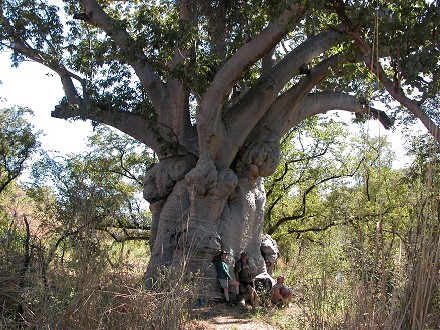 250 km towards Wyndham and onto the Gibb River road (Eastern end), where
the Pentecost River keeps the road closed during the wet. The crossing has
been open only for two weeks, roadwork's still repairing last wets flood
damage. Graders levelling dumped gravel on the river crossing. We watched
a couple of 4x4's cross, only shallow, before returning to visit El Questro,
a privately operated cattle property opened to tourism, showing some of the
best country the Kimberley has, with five rivers flowing through it.
250 km towards Wyndham and onto the Gibb River road (Eastern end), where
the Pentecost River keeps the road closed during the wet. The crossing has
been open only for two weeks, roadwork's still repairing last wets flood
damage. Graders levelling dumped gravel on the river crossing. We watched
a couple of 4x4's cross, only shallow, before returning to visit El Questro,
a privately operated cattle property opened to tourism, showing some of the
best country the Kimberley has, with five rivers flowing through it.
12/5/04 A 10 km walk, Champagn Pools, alongside the Pentecost
River, paperbarks and pandanus trees slowing its course, large Boabs and fig
trees shading the banks. The trail headed across rocky savannah, hot and
dry, to a series of cool pools. We sat beneath the waterfall, pounding our
muscles, a natural massage before the walk back. Each evening in season, the
bar opens, log fire and often entertainment. Tonight the workers along with
the legendary Buddy Tyson, an aboriginal rodeo stockman, turned celebrity,
entertained us with some bush music.
13/5/04 El Questro caters for campers to over $1000.00
a night all inclusive homestead guests. Most roads are 4 wheel drive. We explored by motorcycle other riverside camping areas, the boat ramp and
the homestead (from a distance), the airport and helicopters flying the well
healed to fishing spots or sightseeing. A long dip in Zebedee hot springs,
set amongst Livistonia palms, relaxing yesterdays muscles before a sandy
motorcycle track to the three hour walk up El Questro Gorge. A popular walk,
rock hopping over and through the creek, fern covered cliffs, cool in late
afternoon. Another relaxing beer during happy hour at the bar.
We explored by motorcycle other riverside camping areas, the boat ramp and
the homestead (from a distance), the airport and helicopters flying the well
healed to fishing spots or sightseeing. A long dip in Zebedee hot springs,
set amongst Livistonia palms, relaxing yesterdays muscles before a sandy
motorcycle track to the three hour walk up El Questro Gorge. A popular walk,
rock hopping over and through the creek, fern covered cliffs, cool in late
afternoon. Another relaxing beer during happy hour at the bar.
Move with us to the next section in Australia
 10-11/3/04 A short jaunt to Tumut where we are catching up
on necessary jobs. Catch up days are becoming more frequent. The lap top
allows easier web page updates, photo manipulation, much of which used to
be done between trips. The digital camera produces instant and many more
photos, all needing sorting, saving and backing up, only a few of which can
enter the web page. The older motorcycle, like us, requires more TLC (tender
loving care), days off.
10-11/3/04 A short jaunt to Tumut where we are catching up
on necessary jobs. Catch up days are becoming more frequent. The lap top
allows easier web page updates, photo manipulation, much of which used to
be done between trips. The digital camera produces instant and many more
photos, all needing sorting, saving and backing up, only a few of which can
enter the web page. The older motorcycle, like us, requires more TLC (tender
loving care), days off.  We watched the departure and shortcut across to the lunch stop watching arriving
bikes then back to town for the finish. An evening meal $80.00 (last minute
tickets for us $30.00) in the town's aeroplane hanger, aeroplane and all.
The locals put on a vaudeville show, black tie service and the presentations.
North won, by a small majority.
We watched the departure and shortcut across to the lunch stop watching arriving
bikes then back to town for the finish. An evening meal $80.00 (last minute
tickets for us $30.00) in the town's aeroplane hanger, aeroplane and all.
The locals put on a vaudeville show, black tie service and the presentations.
North won, by a small majority. 




 Eucalyptus oil was a large industry till the second world war on the island
but wool sheep were more profitable in the war years and the oil production
ceased. Revitalized recently at the hobby level and now growing to commercial
production, mechanization seems to be allowing for a competitive industry
again.
Eucalyptus oil was a large industry till the second world war on the island
but wool sheep were more profitable in the war years and the oil production
ceased. Revitalized recently at the hobby level and now growing to commercial
production, mechanization seems to be allowing for a competitive industry
again.  We visited some of the headlands around the lighthouse, watched the seals
for ages and returning for lunch to the camp watched a friendly echidna rummaging
through the bush looking for grubs and insects. An evening walk from the
camp revealed many koala, waking up to feed in the tree tops, more echidna
and Tammar wallabies emerging from the scrub to graze on open grasslands.
We visited some of the headlands around the lighthouse, watched the seals
for ages and returning for lunch to the camp watched a friendly echidna rummaging
through the bush looking for grubs and insects. An evening walk from the
camp revealed many koala, waking up to feed in the tree tops, more echidna
and Tammar wallabies emerging from the scrub to graze on open grasslands.

 The big Saturday night event this week is dirt track racing, obviously extremely
popular, fielding 30 cars from this small population. Novice cars through
to super modifieds thumped the track, collisions and losses on corners. The
only bright light in a quiet town.
The big Saturday night event this week is dirt track racing, obviously extremely
popular, fielding 30 cars from this small population. Novice cars through
to super modifieds thumped the track, collisions and losses on corners. The
only bright light in a quiet town.  4x4's towing caravans the preferred rig, some heading east but at this time
of year the majority westbound, retirees, poor to wealthy, three months to
the rest of their lives, some happy some wishing they were home. Others on
motorcycles, with or without trailers, pass us, even a gypsy wagon, horse
drawn with dog, all intermingled with the road trains, semi trailers with
an extra trailer. The traffic not busy, just dotted every km or so, even
the roadhouses quiet, with long range fuel tanks and camping wild people
avoiding the high prices where possible. It's never glassed out here, the
wind always blows from one direction or another, we had a hot tail wind,
then a cross wind increasing before a front line of cloud dropped temperatures
12 degrees and a headwind. We camped out, off the road, an old gravel dump
behind a mound of dirt out of the wind, 830 km, away from the roadhouses,
the caravans in rest areas, the sunset and stars to ourselves, just off Australia's
longest straight road, 150 km unbending.
4x4's towing caravans the preferred rig, some heading east but at this time
of year the majority westbound, retirees, poor to wealthy, three months to
the rest of their lives, some happy some wishing they were home. Others on
motorcycles, with or without trailers, pass us, even a gypsy wagon, horse
drawn with dog, all intermingled with the road trains, semi trailers with
an extra trailer. The traffic not busy, just dotted every km or so, even
the roadhouses quiet, with long range fuel tanks and camping wild people
avoiding the high prices where possible. It's never glassed out here, the
wind always blows from one direction or another, we had a hot tail wind,
then a cross wind increasing before a front line of cloud dropped temperatures
12 degrees and a headwind. We camped out, off the road, an old gravel dump
behind a mound of dirt out of the wind, 830 km, away from the roadhouses,
the caravans in rest areas, the sunset and stars to ourselves, just off Australia's
longest straight road, 150 km unbending.  The vegetation grew to taller salmon gums, from short saltbush, their outer
bark recently dropped revealing silky salmon coloured trunks and shiny leaves.
One roadhouse for fuel, then Norseman for fresh bread lunch and Esperance
on the coast to rest. A real town, supporting the wheat industry, also catering
for the tourists. An evening walk along the beach but mainly resting, 1400
km in two days.
The vegetation grew to taller salmon gums, from short saltbush, their outer
bark recently dropped revealing silky salmon coloured trunks and shiny leaves.
One roadhouse for fuel, then Norseman for fresh bread lunch and Esperance
on the coast to rest. A real town, supporting the wheat industry, also catering
for the tourists. An evening walk along the beach but mainly resting, 1400
km in two days.  Most people however come to this region for the wineries, not as famous as
Margaret River, to the west, but the drier area produces rieslings and chardonnays,
as well as reds. We joined many Easter wine tasters, visited two wineries
and took a sample back for dinner, same campground.
Most people however come to this region for the wineries, not as famous as
Margaret River, to the west, but the drier area produces rieslings and chardonnays,
as well as reds. We joined many Easter wine tasters, visited two wineries
and took a sample back for dinner, same campground. 
 just to pick up a couple of replacement bags made especially for us by Andy
Strapz. Two bags for our mattresses and two bags for the sleeping gear (bag,
sheet and pillow) which sits in the sun on the outside of the bike. Headed
a further 100 km north, 500 km total including an oil change.
just to pick up a couple of replacement bags made especially for us by Andy
Strapz. Two bags for our mattresses and two bags for the sleeping gear (bag,
sheet and pillow) which sits in the sun on the outside of the bike. Headed
a further 100 km north, 500 km total including an oil change.  We bought a non-export quality (more than one leg missing) half kilogram
lobster, $12 Aust, just for a taste. This area of coastline is also famous
for shipwrecks. The Dutch trying to reach Indonesia (the spice islands) in
the 1600's occasionally ploughed into Australian islands before they could
head north. The first known white people to come ashore to Australia to live
were from the wreck the Batavia in 1629. Originally stranded on offshore
islands where they mutinied and murdered each other, two were put ashore
on the mainland and left. Blood samples of local aborigines indicate a Dutch
disease, prevalent in Holland at the time, also carried in the indigenous
blood, indicating co-habitation with the natives.
We bought a non-export quality (more than one leg missing) half kilogram
lobster, $12 Aust, just for a taste. This area of coastline is also famous
for shipwrecks. The Dutch trying to reach Indonesia (the spice islands) in
the 1600's occasionally ploughed into Australian islands before they could
head north. The first known white people to come ashore to Australia to live
were from the wreck the Batavia in 1629. Originally stranded on offshore
islands where they mutinied and murdered each other, two were put ashore
on the mainland and left. Blood samples of local aborigines indicate a Dutch
disease, prevalent in Holland at the time, also carried in the indigenous
blood, indicating co-habitation with the natives. 


 Yardie Creek Gorge at 6.30 am, brilliant colours, mirrored in the clear waters.
More snorkelling, three more locations, plate corals, staghorn, blue lagoon
coloured water, warm in and hot out of the water. Watched another sunset,
moon rise and bright stars.
Yardie Creek Gorge at 6.30 am, brilliant colours, mirrored in the clear waters.
More snorkelling, three more locations, plate corals, staghorn, blue lagoon
coloured water, warm in and hot out of the water. Watched another sunset,
moon rise and bright stars.  Ore trains shunt through town regularly, iron ore to the coast 300 km away.
We cooked another gel battery 50 km out of town, just two months old, not
sure now if it's the bike's electrics or the batteries that are the problem.
Bought a small quad bike battery and mounted it on the rear footboard, leads
extended, obviously no H-D batteries available around here. The failure also
seems to have blown something in the alarm system, it re-arming itself every
30 seconds even when we are riding, so we arrived in town well noticed, Kay
holding the remote disarmed it each time it re-armed, siren blaring. Exhausted,
just before dark, we could relax after setting up camp.
Ore trains shunt through town regularly, iron ore to the coast 300 km away.
We cooked another gel battery 50 km out of town, just two months old, not
sure now if it's the bike's electrics or the batteries that are the problem.
Bought a small quad bike battery and mounted it on the rear footboard, leads
extended, obviously no H-D batteries available around here. The failure also
seems to have blown something in the alarm system, it re-arming itself every
30 seconds even when we are riding, so we arrived in town well noticed, Kay
holding the remote disarmed it each time it re-armed, siren blaring. Exhausted,
just before dark, we could relax after setting up camp. 
 This area used to be sacred to the aborigines, a special place. It is also
now a place where quiet enjoyment is better appreciated.
This area used to be sacred to the aborigines, a special place. It is also
now a place where quiet enjoyment is better appreciated.  After 5 pm only 1/2 cartons and small bottles of spirits to be sold. As we
cannot discriminate in this country on race or creed everyone in the region
must abide by the same rules. Broome is famous for its pearls, having the
largest pearl oyster, it used to produce 80% of the world's mother of pearl
shell for buttons. Long ago the industry died out replaced by plastics or
cultured pearls but its history still draws tourists to the area. The warm
climate and a large supply of pearl jewellery shops keeps them entertained.
We checked out a few shops, buying nothing, marvelling at the array of artwork,
and the price of this product of man and nature.
After 5 pm only 1/2 cartons and small bottles of spirits to be sold. As we
cannot discriminate in this country on race or creed everyone in the region
must abide by the same rules. Broome is famous for its pearls, having the
largest pearl oyster, it used to produce 80% of the world's mother of pearl
shell for buttons. Long ago the industry died out replaced by plastics or
cultured pearls but its history still draws tourists to the area. The warm
climate and a large supply of pearl jewellery shops keeps them entertained.
We checked out a few shops, buying nothing, marvelling at the array of artwork,
and the price of this product of man and nature. 

 I walked to its more dark end in the evening where, as happens every night,
a couple of hundred aborigines gather inside or outside the local hotel to
drink. An old man was sitting in the gutter singing, playing his guitar, three
or four women singing along melodiously. Small groups of half a dozen were
sitting on the road, at its edge or in the long grass, with their mates,
ones who had the money or alcohol. There were no other white people there
other than security who politely vetted who was or was not allowed entry
to the pub. Dress and alcoholic state the main criteria but previous disturbance
offenders also banned. It was described as a quiet evening, everyone happy,
friendly, shaking my hand or telling me stories of themselves. All ages from
18 to death, their children fending for themselves to follow their parents
when they reach drinking age. Most live in the long grass, emerging on their
government hand out day to collect from the bank and return it through the
bar.
I walked to its more dark end in the evening where, as happens every night,
a couple of hundred aborigines gather inside or outside the local hotel to
drink. An old man was sitting in the gutter singing, playing his guitar, three
or four women singing along melodiously. Small groups of half a dozen were
sitting on the road, at its edge or in the long grass, with their mates,
ones who had the money or alcohol. There were no other white people there
other than security who politely vetted who was or was not allowed entry
to the pub. Dress and alcoholic state the main criteria but previous disturbance
offenders also banned. It was described as a quiet evening, everyone happy,
friendly, shaking my hand or telling me stories of themselves. All ages from
18 to death, their children fending for themselves to follow their parents
when they reach drinking age. Most live in the long grass, emerging on their
government hand out day to collect from the bank and return it through the
bar.

 250 km towards Wyndham and onto the Gibb River road (Eastern end), where
the Pentecost River keeps the road closed during the wet. The crossing has
been open only for two weeks, roadwork's still repairing last wets flood
damage. Graders levelling dumped gravel on the river crossing. We watched
a couple of 4x4's cross, only shallow, before returning to visit El Questro,
a privately operated cattle property opened to tourism, showing some of the
best country the Kimberley has, with five rivers flowing through it.
250 km towards Wyndham and onto the Gibb River road (Eastern end), where
the Pentecost River keeps the road closed during the wet. The crossing has
been open only for two weeks, roadwork's still repairing last wets flood
damage. Graders levelling dumped gravel on the river crossing. We watched
a couple of 4x4's cross, only shallow, before returning to visit El Questro,
a privately operated cattle property opened to tourism, showing some of the
best country the Kimberley has, with five rivers flowing through it.
 We explored by motorcycle other riverside camping areas, the boat ramp and
the homestead (from a distance), the airport and helicopters flying the well
healed to fishing spots or sightseeing. A long dip in Zebedee hot springs,
set amongst Livistonia palms, relaxing yesterdays muscles before a sandy
motorcycle track to the three hour walk up El Questro Gorge. A popular walk,
rock hopping over and through the creek, fern covered cliffs, cool in late
afternoon. Another relaxing beer during happy hour at the bar.
We explored by motorcycle other riverside camping areas, the boat ramp and
the homestead (from a distance), the airport and helicopters flying the well
healed to fishing spots or sightseeing. A long dip in Zebedee hot springs,
set amongst Livistonia palms, relaxing yesterdays muscles before a sandy
motorcycle track to the three hour walk up El Questro Gorge. A popular walk,
rock hopping over and through the creek, fern covered cliffs, cool in late
afternoon. Another relaxing beer during happy hour at the bar.